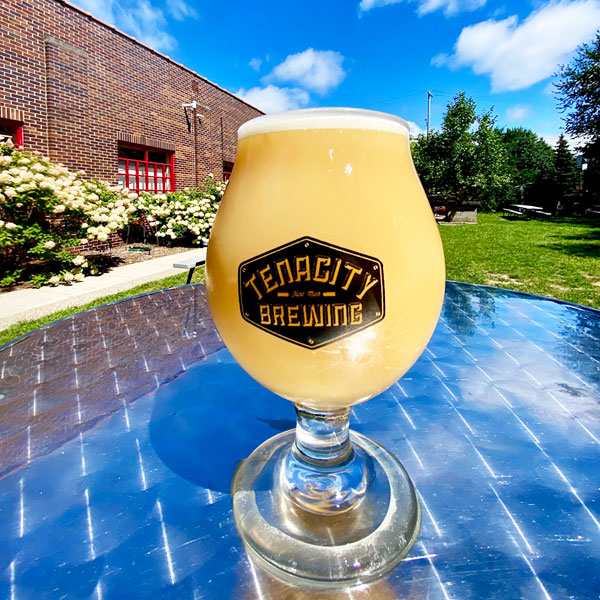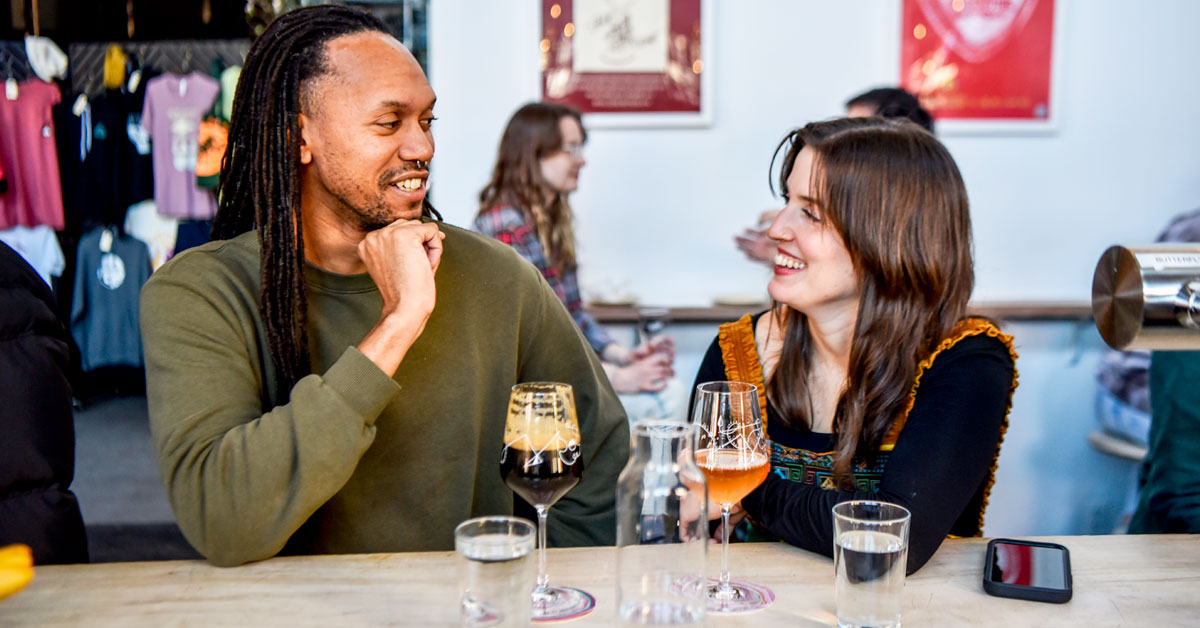“Always offer at least a glass of water to your guests.” As a child of immigrants, I understood this simple maxim to be a baseline for good hosting. I learned secondhand that India was a place where unexpected visitors and open-door policies are the norm. I couldn’t have anticipated how these ways of moving through the world would translate within my professional life in the craft beer industry.
I cut my teeth bartending in Seattle’s Ballard Brewery District, where converted warehouses and a lingering spirit of maritime culture color the neighborhood with an approachable brand of grittiness. A spectrum of people, from college students to tourists, brewery hop (or cycle) in an attempt to complete their Ballard Brewed Passport. Offering a glass of water at the sight of happy, flushed faces felt instinctual.
Access to water is both a basic human right and a universally understood sign of hospitality. As I dove into the origins of my learned behavior, I began to wonder whether water service at restaurants and bars in America could be traced to cross-cultural water customs. Water (usually) costs nothing to customers, but the unspoken condition for existing in third places is that you need to buy something. What happens when the third place no longer fits a guest’s lifestyle? In the context of craft brewery taprooms, water can play a role in creating the sense of belonging and safety intrinsic to building hospitable community spaces.
Common Resource, Not Commodity
In a 2005 paper for the Yale Journal of Law & Humanities, environmental policy expert James Salzman describes ancient and indigenous water-sharing practices across four different continents. Despite different management approaches, “water is regarded first and foremost as a common property resource, not as a commodity.”
So-called “Right of Thirst” is observed in traditional Jewish and Islamic water law: Free access to drinking water for community members and outsiders was recognized and prioritized over agricultural and domestic water use. It was considered sacrilegious to squander a divine gift from God.

“Sharing norms” in Zimbabwe are cautionary: Owners of private water sources defend against literal—and spiritual—poisoning by being open for communal drinking. In Bihar, India, only upper caste members could make use of sacred water sources; lower castes drew from separate sources to avoid “cross-pollution.” In both cultures there is obvious regard for sharing in times of water scarcity, although this behavior seems to be rooted in fear. Australia is the world’s driest inhabited continent, and “always ask” rules within Aboriginal communities respect knowledge of water sources as intellectual property. Almost nobody is turned away.
In Drinking Water: A History, Salzman explains the very human origins of the inclination to share: “Any traveler in an arid region could foresee a situation where he or she might need water from strangers for survival. A rule that gave water to those in need might very well one day benefit them or their tribal members.”
Belonging, Without Beer
We’re all just looking for a place to land. Whether they are part of our community or visiting us from afar, our guests come to us thirsty—and the craft beer industry is changing. Sober-curious bars are popping up all over NYC, and Gen Z is reevaluating its relationship with alcohol. Tacoma, Washington’s E9 Brewing recognized this shift and installed a kegerator of free sparkling water in June 2020. The production crew and bartenders were early imbibers, but their customers didn’t catch on right away. Around that time, head brewer Shane Johns had cut back his beer intake, too: “What we found was that people preferred a flavor. That’s more of a La Croix phenomenon.”
Beer is an acquired taste. As a taproom manager, I am familiar with how exclusive craft beer spaces can be. I’ve lost count of how many times I’ve greeted someone at the bar who halfheartedly begins with, “I’m not usually a beer drinker.” This kind of taproom guest is usually looking for a way to feel included alongside the beer lover they have accompanied. Whether customers have a gluten allergy, don’t like the flavor, or simply aren’t familiar with the landscape of beer styles, building inclusive taprooms isn’t as straightforward as removing the alcohol. Flavored water is a made-in-house option for guests who may not typically “belong” in the taproom: pregnant people, children, and Muslim friends, to name a few.
In January 2023, E9 launched Tahoma Hop Water in two flavors, lemon and lime. A year later, it now produces three additional flavors: passionfruit, grapefruit, and pineapple. Sharing a name with the indigenous Puyallup Tribe’s title for iconic Mount Rainier, “Mother of Waters” is made with Mosaic hops from the Yakima Valley and soft, chuggable water that flows from the mountain through the rest of the Green River Watershed. It’s an incredibly accessible beverage.
“My five-year-old daughter drinks it,” says Johns.
Johns noted that hop water is not flying off their shelves, but it is easy to make. It also seems to create a welcoming atmosphere for everyone, from the guys who are “old in the beer game” and those guests who just want to hang out with their friends. Some stick solely to hop water. It doesn’t need to be a bestseller to meet customers where they are.
“I think people feel awkward if they don’t have something in front of them when they’re at a brewery… Maybe now they’re going to have a hop water in between two IPAs.”
Water and Tenacity
It is telling that in a book about drinking water, Salzman calls out alcohol as a historically trusted alternative in the absence of safe water sources: “In many cultures, the most effective strategy to avoid unsafe drinking water has been to avoid water altogether.”

I wondered: Did pub culture emerge in individualistic (versus collectivistic) cultures, in places where hospitality norms were not so clearly defined and travelers still needed safe places to retire? Craft breweries are everywhere now. When I am traveling to a new place, I make it a point to visit at least one because it helps me feel immersed in a local culture. In October 2020, circumstances in my personal life brought me to “Vehicle City”— Flint, Michigan—and Tenacity Brewing.
Here is a city with true grit: A public health emergency unfolded just a few months after Tenacity opened in 2014. The majority-Black city’s drinking water became lead-contaminated when government officials switched its water source to the Flint River. Tenacity co-owner Robb Klaty and his team observed wild swings in pH early on: “We began trucking in water from a neighboring community for months while it got sorted.”
Flint’s only brewery was ready to meet the community’s water needs. Most modern brewers use reverse osmosis to adjust a water’s mineral profile and start with a blank canvas for flavor. This process also removes lead contaminants. Regular independent lab tests, government tests, and in-house tests were not enough to assuage the public fear that emerged at the time.
“We did offer our tested and verified water free to the community at the time and looked at multiple ideas to help, but the incredible amount of bottled water coming in from outside of Flint along with the skepticism about anything associated with Flint—even if it was tested—left us in the position as a recipient of generosity from the outside that we were grateful for,” Klaty says.
I am sure that I am part of a majority of taproom managers who think of their businesses as community spaces. I wonder what I would do if my community was so shaken in the face of a crisis that my support couldn’t reach them. Where would we go from there? I recall a quiet, tentative mood on the day I visited Tenacity. Public spaces were just reopening after COVID-19 stay-at-home measures.
“People who have been here for some time have seen plenty of ups and downs,” Klaty says. “There is a feeling that there is always some challenge now or around the corner … that’s life.”
‘A Glass of Water Doesn’t Cost Anything’
Thirst is a tangible need. Humans can only survive without water for about three days. How long can you go without seeing another person? Perhaps by seeing each other, we are better able to see ourselves. Water’s emergence as a hospitality tool feels like some form of self-preservation: Meeting these small needs for others can help us to begin to make meaning of our own humanity.
I began this piece by seeking my grandmother’s words. I asked her about the origins of the hospitality practice she instilled in me, hoping for answers. Upon my insistent questioning, she illustrated what was obvious to her (and imprecisely translated here):
“We give guests honor when they come to our home … by doing so, both our honor and their honor increases. If someone comes, we invite them in and that costs us nothing. Speaking doesn’t cost anything, sitting doesn’t cost anything, giving them a glass of water doesn’t cost anything. We ask for nothing, but if they come, we invite them in with love.”
CraftBeer.com is fully dedicated to small and independent U.S. breweries. We are published by the Brewers Association, the not-for-profit trade group dedicated to promoting and protecting America’s small and independent craft brewers. Stories and opinions shared on CraftBeer.com do not imply endorsement by or positions taken by the Brewers Association or its members.


Share Post